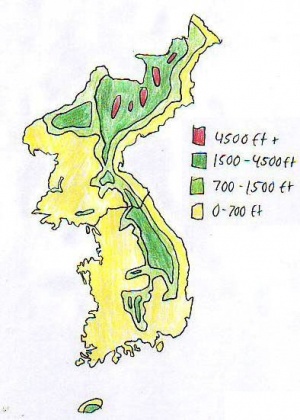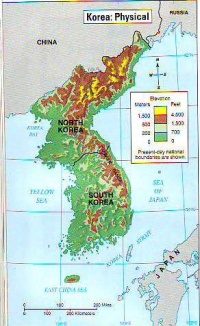World Cultures Portfolio/Korea
From ThePlaz.com
World Cultures Korean Report about Physical Map
Intro/Basics - Africa - Middle East - South Asia - China - Japan - Korea - Latin America
Only spent one day on this unit World Cultures Daily Questions
Notebook
Portfolio
- Portfolio
- Physical Map Report
Africa: HDI Graph Reflections - Decolonization Report
Middle East: Population Density Report - Essay: A Peaceful Vacation
South Asia: Rainfall Report - South Asia Comparisons Graph - Postcards
China: Sphere of Influences Report - Mao Button Journal
Japan: Natural Resources Report - Japanese Violence Journal
Korea: Physical Map Report
Latin America: Landforms Report
Worldwide: T-Shirt Trade Report
The rocky mountains of Korea shape its culture and society greatly. The 8 mountain ranges restrict the amount of farmland available (Encyclopedia Mytha). This might create a dependence on external food sources. Rice and Vegetables represent the primary crop (Blue Textbook 375).
Mountains cover 70 percent of the Korea Peninsula (Blue Textbook 376). The T'aebaek Range runs on along the east of Korea. The mountains are higher in Northern Korea then in South Korea. Only the north has mountains over 4,500 feet (Textbook). These are in the north-eastern section of the country. Less tall mountains surround them. The mountains lay mostly on the east side of Korea, leaving the west for farming and fishing. In addition, only about 25 percent of Koreans live in the mountainous regions (Blue Textbook 376). Also the mountains do not extend the full way to the bottom of South Korea freeing the land for farming and industry in the coastal plains.
The coastal plains commonly get divided into 3 regions. The northeast, the west coast, and the south east. The west coastal plain, however, hold both capital cities and most of the industry and population (Blue Textbook 376). In addition, Korea's 6,000 mile coastline makes fishing a big industry (Blue Textbook 376).
Mountains form primarily in two ways. For example in India, the continent smash into the larger continent. Also, mountains can be formed via volcanoes. Sometimes, however, both can play a part. The Encarta tectonic map appears to show a fault line between Korea and China. This points to tectonic activity. However, volcanoes might have played a role in addition to simple plate moving.
Mountains cover about 80% of North Korea (contradiction, combine). This severely limits the amount of farmland. The CIA World Factbook 2006 reports that North Korean arable (farmable) land only makes up 22.4% of the country. South Korea has even less at only 16.58% (USA CIA). This severely limits agriculture, the "gateway" good to industrialization and global trade. Without it, Koreans must import much of their food, or be very efficient at farming what they have. South Korea has breed an industrial society. Tractors and modern farm equipment help make farms much more productive. Thus they can make more crops with less. In addition, the scientific research allows bigger and more disease resistant crops to grow. The south also has a strong industrial industry. The world buys semiconductors, wireless telecommunications equipment, motor vehicles, computers, steel, ships, and petrochemicals from Korea (USA CIA)
North Korea, however, does not have their priorities straight. Its regime thinks only of itself and North Koreans worship their leader. The cities exist eerily quiet and the streets have no cars due to the oil shortage. But the monuments stand massively tall. Huge buildings stand empty, and much goes to waste. A small, select few have much wealth. But most North Koreans starve to death, live in prison camps, or prepare for war via forced military service.
North Korea does have some natural resources however. Coal, iron, lead, copper, zinc and hydroelectric power all exist in North Korea (Blue Textbook 377). However, the government can not efficiently use these resources.
The geography difference between each section of Korea does not differ as much as the difference between the economy and way of life in the respective countries. Perhaps it represents the most striking example of capitalism vs. communism. On one hand, a advanced, free nation making efficient use of its resources, and on the other hand, a poor, corrupt land not making efficient use of its resources. If the state controls all, the likelihood of this happening increases dramatically.
Like all of the other locations around the world, life in Korea depends on geography. (explain more before) But geography does not determine all in Korea. Human can affect more, especially in the modern years when they have learned to move large amounts of earth.
On one side of Korea, an advanced society, on the other, a derelict communist state. Perhaps, more then all, Korea shows what a difference politics can have in the world. But do not forget about its physical features. more
Sources
- encyclopedia mytha
- blue textbook
- http://www.pantheon.org/areas/mythology/asia/korean/korean_mythology.html
- http://www.unsolvedmysteries.com/usm290032.html
- https://www.cia.gov/cia/publications/factbook/geos/kn.html
- https://www.cia.gov/cia/publications/factbook/geos/ks.html
- http://encarta.msn.com/encnet/features/MapCenter/MapPrintPreview.aspx?lat=31.035848839106528&long=138.83994502257167&alt=4&mapsize=Medium&mapstyle=tectonic&mapstyleselectedindex=14&selectedent=131&entityname=




